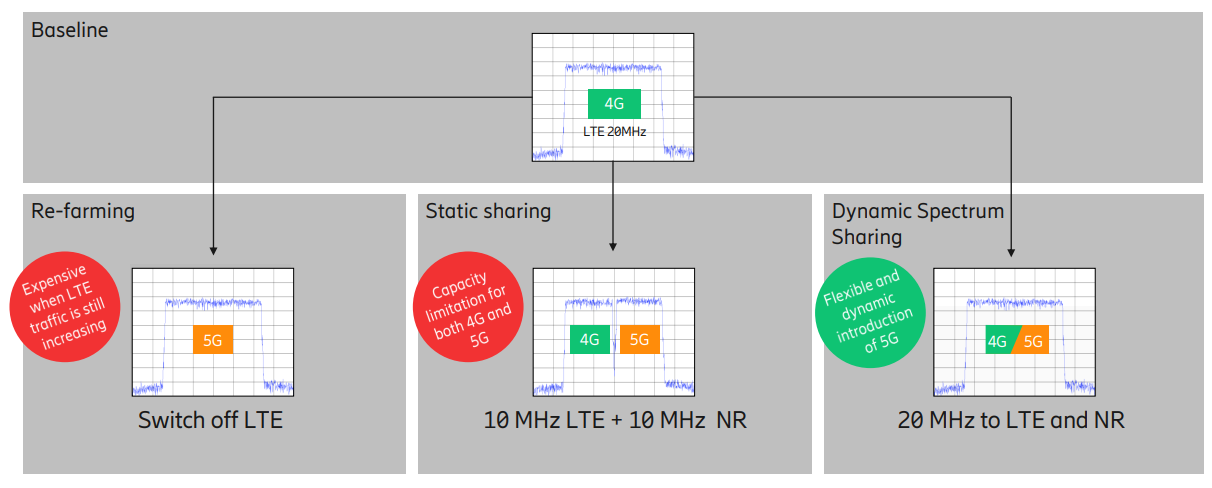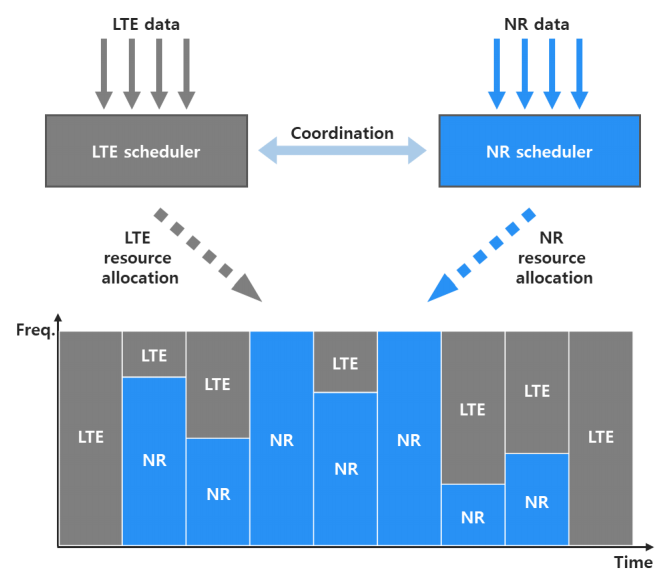Before start talking about DSS or Dynamic Spectrum Sharing, let’s address the problem first and how DSS can solve it. As we know that 5G can support newly released frequency bands for use – such as the C-band (3-5 GHz) and millimeter wave (mmWave) band (24-40 GHz) – are higher than the current 4G frequency bands that sit below 3 GHz.
So while deploying 5G on the high frequencies with wider bandwidth may yield higher data rates, doing so will be inherently disadvantageous in terms of coverage due to the large amount of signal loss via propagation and penetration. A lower frequency spectrum, on the other hand, is favorable for 5G deployment, in that it provides a wide-area coverage. Therefore, for a smooth transition, it is critical to deploy 5G in the lower frequency bands, which are mostly occupied by 4G frequencies.
So What is the logical solution?
Spectrum Refarming is the most logical and straightforward approach. As such, prior to 4G, spectrum re-farming was the conventional choice when transitioning from one generation to the next. Spectrum re-farming is done by Clearing out all previous generation users from a frequency band and reutilizing the same frequency band for next-generation users.
So What is the drawback of Spectrum Refarming?
Today, 4G services dominate most of the communications market and this trend is expected to continue for several years to come. At the early stages of 5G commercial deployment, LTE users outnumber NR users in a given network; therefore, allocating LTE carrier spectrums only for a small number of NR users significantly impact LTE users. So Switch OFF LTE spectrum is really an expensive solution.
Also, Re-farming low band carriers from 4G without a corresponding increase in 5G devices penetration might lead to congestion of the remaining LTE carriers, degrading indoor coverage for LTE users who still represent the majority of the subscriber base.
So What is the next Solution?
The second logical step is to divide the spectrum between LTE and 5G meaning to have a Static Sharing, for example, if we have 20 MHz in LTE Bands to switch it to 10MHz for LTE and 10 MHz for 5G. However, this solution is still hard as it’s limiting the 4G capacity, and also 10MHz is not enough for 5G capacity.

Finally let’s discuss the next solution, DSS or Dynamic Spectrum Sharing!
What is Dynamic Spectrum Sharing?
Dynamic Spectrum Sharing (DSS for short) is a technology that for the first time enables the parallel use of LTE and 5G in the same frequency band. The technology determines the demand for 5G and LTE in real-time. The network then divides the available bandwidth independently and decides dynamically for which mobile communications standard it ideally uses the available frequencies.

The DSS concept is based on the flexible design of the NR physical layer. It uses the idea that NR signals are transmitted over unused LTE resources. With LTE, all the channels are statically assigned in the time-frequency domain, whereas the NR physical layer is extremely flexible for reference signals, data, and control channels, thus allowing dynamic configurations that will minimize a chance of collision between the two technologies.
Why Spectrum Sharing?
- Dynamic Spectrum Sharing will allow “soft” re-farming to NR with minimal impact on LTE performance.
- Introduce 5G in existing 4G bands without hard/static refarming spectrum.
- Lowest TCO for 5G introduction.
- Shared infrastructure+ Spectrum.
- Rapid deployment of 5G services using existing-based deployment.
- Co-existence of LTE devices and standalone (SA) NR devices.
- Effective utilization of valuable low/mid-band spectrum.
- The issue of limited coverage that rises from deploying NR on mmWave or mid-band spectrum can be compensated for, by implementing DSS on low-band carriers and aggregating the low-band carrier with the higher band carrier.
- DSS also requires fewer sites for new 5G antennas. Instead, today’s infrastructure can be optimally used and utilized. This saves time and money.
How does DSS work?
DSS provides flexible resource management that corresponds accordingly to NR UE penetration and NR traffic demand, resulting in high spectrum utilization.
DSS is dynamically allocating resources according to traffic demands between LTE and NR across the entire band. To enable this feature, LTE and NR schedulers must coordinate with each other in order to interchange traffic status or resource sharing status, as well as dynamically assign available resources in a synchronized manner.

Through sophisticated coordination between schedulers, LTE resource allocation increases and NR resource allocation decreases when LTE traffic peaks; and vice versa when NR traffic peaks. This enables dynamic resource allocation for instantaneous NR traffic bursts that may occur even in early NR markets, as well as for the steady increase in NR demand over time as NR takes mainstream.

In mixed-mode baseband configuration, Ericsson’s unique interface will be used to ensure coordination between LTE and NE schedulers to maintain inter-RAT fairness, compare scheduler or RB priorities and could follow all rules of both RATs and produce the best possible outcome.
DSS Requirments by 3GPP
Initially, the NR adopted the orthogonal frequency division multiplexing (OFDM) waveform as its baseline, with the basic numerology of 15 kHz sub-carrier spacing (SCS) support (scalable by the power of 2), which was compatible with the waveform and numerology of LTE. This enabled a highly aligned resource grid structure between LTE and NR, providing a fundamental basis to support LTE-NR co-existence.
Moreover, to support the efficient co-existence between LTE and NR, the following requirements were described in the NR standardization:
- Support co-existence of LTE UL and NR UL within the bandwidth of an LTE component carrier and coexistence of LTE DL and NR DL within the bandwidth of an LTE component carrier, and identify and specify at least one NR band/LTE-NR band combination for this operation.
- Minimize impact to NR physical layer design to enable this co-existence.
- No impact to the ability of legacy LTE devices to operate on the LTE carrier co-existing with NR.
- No implication that all UEs have to support the simultaneous connection of NR and LTE in the bandwidth of an LTE component carrier.
Stay tuned for part 2 to see How DSS dynamically allocate the PRBs to LTE and NR User!
Resources: 3GPP, Ericsson DSS, Samsung DSS, Mediatek, Deutsche Telekom
